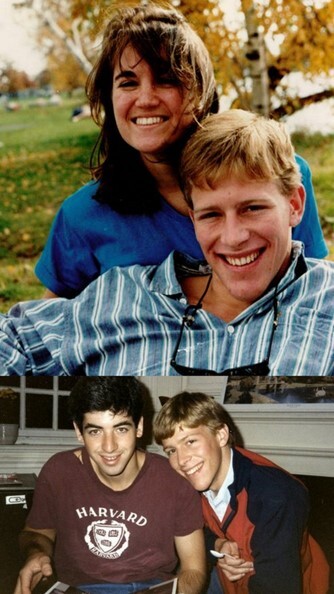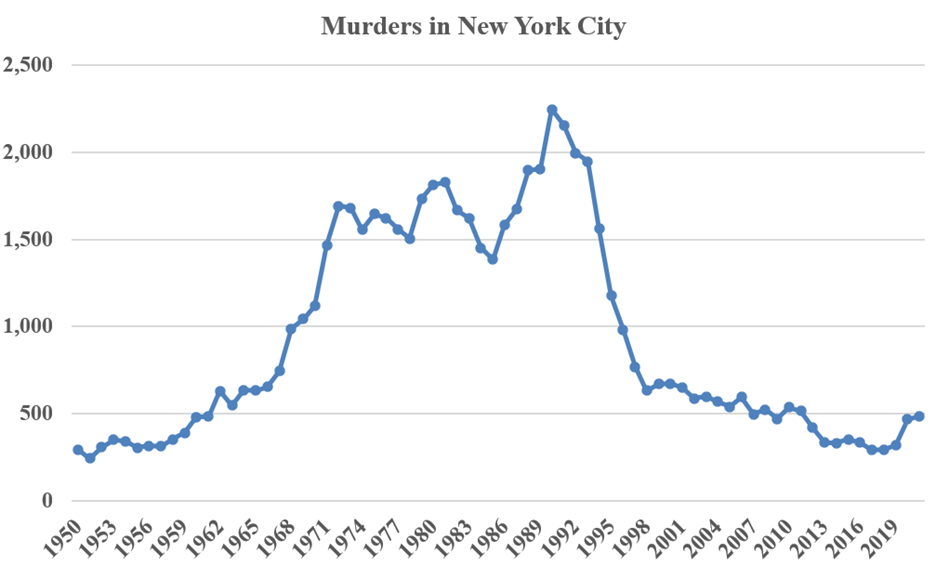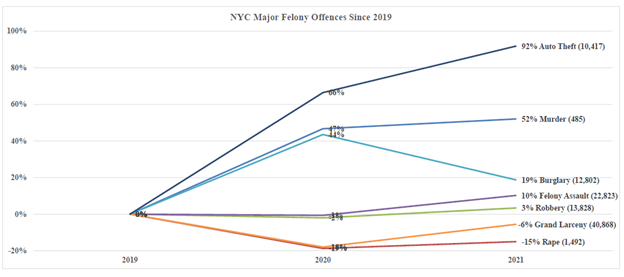New York is the greatest city in the world... but it has a crime problem right now
With a population of 8.5 million, my hometown of New York City is, by far, the largest city in the U.S. – more than twice the size of the next-largest city, Los Angeles. And with a metro area gross domestic product ("GDP") of $1.6 trillion in 2019, it accounted for an enormous 7.3% of the GDP of the entire country.
So what happens here affects every American.
Before I talk about where NYC is today and, in particular, its crime problem, let me tell you a little about my history with the city...
I met my wife Susan in Boston in the first week of September 1990, when Bill Ackman and I crashed the Harvard Law School freshman orientation booze cruise of Boston Harbor (Bill's college roommate was a classmate of Susan's and invited him to be his wingman, and Bill invited me to be Wingman No. 2).
Susan and Bill grew up in adjacent towns outside the city (Armonk and Chappaqua, respectively) and she remembered him from a decade earlier – he was very recognizable, even back then! – and came over to talk. I elbowed my way into the conversation and the rest is history... Susan couldn't keep her hands off me from day one (that's my story, and I'm sticking with it!). (Given Bill's success, I often joke that she married the wrong hedgie!) Here are pictures of me with each of them back then:
Susan finished law school in 1993, we got married that October, and after I finished business school the following May, I followed her to New York.
I remember having very mixed feelings about the move to the Big Apple – not the least of which because, having lived in western Massachusetts and Boston for the previous 16 years, I'd grown up cheering for my beloved Red Sox to beat the dastardly Yankees, which, sadly, hadn't happened very often at that point (don't even mention the names Bucky Dent and Bill Buckner to me!). (My grandfather and I used to watch Sox games together. He died in 2002 without ever seeing them win the World Series – which they then proceeded to do four times from 2007 to 2018!)
But New York grew on me – I even root for the Yankees if the Red Sox aren't in the playoffs – and now, nearly 28 years later, I wouldn't dream of living anywhere else. I've spent time in nearly every major city in the world and I can tell you with certainty that New York is the greatest! Those who have fled to the suburbs or moved to Florida (egads!) are out of their minds, in my opinion. (As one of my friends once remarked to me: "The whole point of being rich is being able to live wherever you want.")
But New York was hit hard by the COVID-19 pandemic. In some ways, the city has bounced back strongly – for example, if you're a young person trying to find an apartment to rent, good luck! I wrote about this in July: New York City Is Roaring Back to Life.
But the midtown office buildings normally filled with hundreds of thousands of high-earning (and high-tax-paying) professionals (bankers, hedge fund managers, lawyers, accountants, consultants, etc.) remain eerily empty. The city cannot recover economically until these people move back to the city and come back to the office (at least part time).
As I discussed in yesterday's e-mail, the good news is that COVID-19 is in steep decline here and I don't think it's coming back, so that barrier will soon be gone. But that's not the only thing that matters...
Many things affect the strength and future of a city: its cultural and educational institutions, public transit, housing, taxes, cleanliness, etc. But undoubtedly one of the most important is crime – an issue I've been deeply involved with for the past five years.
Overall, crime is down dramatically in the city over the past two decades. Here's a chart going back to 1950 of the crime that generates the most fear and headlines, murder:
You can see that the number of murders last year was down 78% from the peak in 1990 – but it jumped 47% in 2020 and is up 64% in the past three years, which, to some extent mirrors national trends (murders rose 29% nationwide in 2020).
I pulled together a 19-slide presentation with the latest data on many types of crime in NYC over the past two years and as well as the past month, which you can download here. Here's the key chart:
The trends are, overall, upward, which is leading to much consternation among most New Yorkers, which has only been fueled by a number of highly publicized attacks in the past week:
- Michelle Alyssa Go, a 40-year-old consultant at Deloitte, was pushed in front of a subway car and killed in the Times Square station by a homeless man with a history of mental illness (this resulted in the following front-page headline in the New York Times: Eric Adams Ran on Making New York Safer. A Subway Killing Poses a Test)
- Kristal Bayron-Nieves, a 19-year-old cashier at a Burger King in East Harlem, was shot to death by a man with four prior arrests... including for criminal possession of a weapon in an incident during which he brandished a knife
- A New York City police officer was hospitalized in stable condition after being shot while sleeping in a car between shifts outside a station house in East Harlem
On a personal note, the largest independent men's clothing store in the city, Rothmans, which is owned by my friends Ken and Jim Giddon, was robbed in broad daylight twice in the last three weeks of December by the same group of young men (five the first time, eight the second time). They brazenly tore apart the store, assaulted an employee, and grabbed as much merchandise as they could carry out. Here's the full story that they told the New York Post: NYC shopkeeper robbed twice by marauding bandits.
(By the way, I buy all of my nice clothes at Rothmans. If you ever shop there – and you should, as it's a great store and New Yorkers need to support local businesses like this – tell Ken and Jim that you're a friend of mine and they'll give you a nice discount.)
Statistics and stories like these led five of my friends to share the following comments with me:
- A friend on Leonard St. in Tribeca: "I am afraid for my children, my friends and myself. And I can, I am leaving like everyone else that can (making things much worse as the tax base erodes). This is misplaced ideology at its finest! When will you see this? Will it take the death of a friend or family member or the complete loss of quality of life around your house? There are other solutions to help solve these problems."
- A friend on 83rd and Central Park West: "My wife and I are as progressive as they come, but we're furious that rising crime isn't being dealt with more aggressively."
- A friend on 89th and Columbus: "I went into the CVS across the street to buy some deodorant and the shelves were empty. The pharmacist said every day, eight people come in with bags and openly steal everything that's not behind plexiglass. Headquarters told us not to intervene to avoid possible violence."
- A friend near Washington Square Park: "There's always been open drug dealing and drug use in the Park as well as general disorderliness and trash, but it's gotten much worse in the past two years due to a number of factors: 1) The pandemic leading to people and stores empty, loss of community, eyes on the street; 2) Lack of opportunity once someone hits hard times; 3) National leadership (Trump) creating division and hopelessness; 4) City leadership (de Blasio) absent, nearly useless; 5) Global oversupply of fentanyl and meth, price dropping; and 6) police in the aftermath of the BLM protests and calls to defund the police saying, 'OK, we'll let you see what things are like if we stop doing our jobs...'"
- A friend on 73rd and Broadway: "It's not as bad as it was in August 2020, right after they moved a lot of drug addicts into local hotels, but it's worse than it was pre-Covid. It's a function of how crowded the streets are (or aren't). It's dead here after 9pm. Restaurants close earlier. Lots of bodegas and other 24-hour or late-night spots went out of business. It can be desolate after 9 or 10pm, especially on cold nights. No one is out. It was busier in the spring and summer. It feels dicier now. There are more threatening people on the subway and you are more likely to end up on empty or near empty , which leaves most women feeling vulnerable."
The reasons behind the increase in crime are highly complex. I'm not going to dive into this topic right now because it's so complex – and so politically charged. I will say, however, that the storyline that it's all due to soft-on-crime liberals is too simple.
Consider that some of the places that have that highest crime rates (here's a list of the 100 most dangerous cities in the U.S. with 25,000 or more people, based on the number of violent crimes per 1,000 residents... New York City isn't even on it) and/or have seen the biggest surges in crime in the past two years are smaller cities in red states in which there have been no reform initiatives (I suspect in many such areas, rising crime is due to economic desperation related to the pandemic and/or increasing meth or fentanyl addiction).
What is clear, however, is that the new mayor, police commissioner, and district attorney in NYC need to get on the same page – both in reality and perception – to develop effective responses to rising crime.
Best regards,
Whitney
P.S. A quick follow-up to my recent e-mails on online sports gambling. It seems to be possible, at least in some cases, that if someone signs up using my refer-a-friend link, the free $50 or $100 bonus negates the other, much more attractive new customers offers, so do not use the links I included in my e-mails – just Google the companies' websites and sign up directly.
P.P.S. I welcome your feedback at WTDfeedback@empirefinancialresearch.com.


